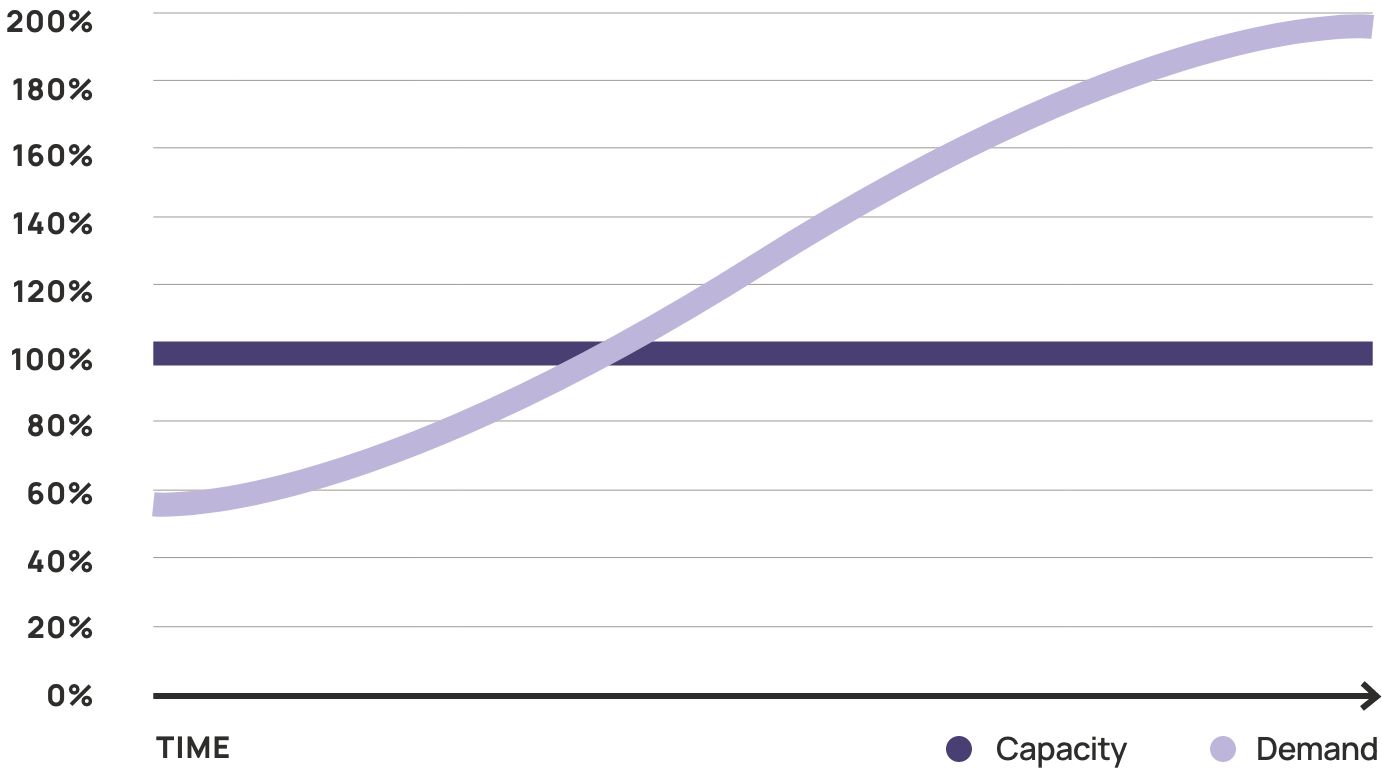Introduction
Success requires a business to have a strong understanding of the market’s demand for its company’s goods and services along with deep insights into how well it can supply what clients are demanding.


There are a wide variety of benefits that come from accurately forecasting capacity. These include:
Understanding your current demand
Detailed insights into maximum capacity
Reliable forecasting of future demand
Effective resource management and staffing
Fast scaling for demand fluctuations
Conquering the Hierarchy of Capacity Planning Needs
This hierarchy of needs can be applied to how a company understands its capacity and begins to take steps to optimize it, moving from basic data collecting to optimization made possible through the use of Business Intelligence. In this ebook, we will walk through the five levels of the capacity planning hierarchy of needs, what you will need to do in order to reach each level and the benefits that are found at each level.
In addition, each of these levels will be paired with definitions from Service Performance Insight (SPI) Research regarding the 5 levels of Professional Services (PS) Maturity. As an organization matures and moves up its hierarchy of needs, the better it will be able to forecast and optimize its capacity.


“At this level, business processes are ad hoc and fluid. The business environment is chaotic and opportunistic and the focus for a professional services organization is primarily on new client acquisition and reference building. Success depends on the competence and heroics of people in the organization and not on the use of proven processes, methods or tools.”INITIATED: SPI PS MATURITY DEFINITION
How to Reach the Initiated Level
Collecting and Analyzing Needed Data
It’s more than likely that your business is already generating a massive amount of data on projects, resources and client demand, but not all of this is necessary for capacity planning. To reach the Initiated Level, a business must first identify the data it needs for resource capacity and client demand insights.
SALES OPPORTUNITY PIPELINE
Knowing potential sales at all levels will give you insight into increases or decreases in demand for the foreseeable future.
ENGAGEMENT DELIVERY METRICS
How well is your company communicating with potential and existing clients? These metrics will help determine changes in demand.
HISTORICAL DATA AND TRENDS
What past data shows the ups and downs in demand that your company has experienced? History and trends can help you predict the future.
DELIVERY BACKLOG
What projects have been delayed and which are about to begin? Understanding your backlog shows where resources will soon be assigned.
RESOURCE SCHEDULES
Having complete recordings of your resources’ tasks and project commitments for the foreseeable future will help determine the amount of availability for new projects and clients.
HIRING TIMELINES
How long will it take for your team to hire a new member? Having a timeline based on past experiences shows when your capacity for more projects will increase.
RAMP TIME
What is the average time between hiring a resource and he or she can be fully utilized? Ramp time is critical for your strategy.
ATTRITION DETAILS
The rate at which your team members leave the company is critical in knowing capacity. Use actual attrition and forecasted attrition to know when decreases are likely to occur.
Remember that correctly identifying any and all necessary data here is critical, as all future levels will be built on this foundation. With this in place and used by all applicable parties in your company, you can be assured that the data being used for critical decisions is trustworthy.
Correctly Preparing Data
Once your organization has identified the systems that are producing these data subsets, you will need to prepare this data in effective, replicable ways. Make sure your data collection process adheres to the following structure:
DATA GOVERNANCE
Create roles and guidelines that ensure all data being entered is of good quality, consistently inputted and assessed by the correct parties.
DATA ARCHITECTURE
Organize your data into tables and accounts that determine access, performance and storage details, which will define data elements, structures and relationships.
DATA MODELING
Create models, policies and standards that through which data must be collected, stored, arranged and used in your data systems.
DATABASE STORAGE
Ensure that the system used to store your data and the administration in charge of it is secure and working in the way your business needs.
REFERENCE AND MASTER DATA
Create an authoritative source of master data to provide a single point of reference that removes duplicates, prepares data and eliminates incorrect information.
Abilities Granted by This Level
Measure Your Current Demand
Correctly preparing your data will provide the following insights:
PAST SALES RECORDS
The total units sold over the past year for a measurement of the marketplace and the effectiveness of your current strategy.
PROJECT BACKLOG
See how many projects have not been started yet, but are scheduled to begin in the near future.
SALES PIPELINE
View all potential clients ranging from prospects to qualified leads to clients who have officially closed for current and incoming demand.
COMPETITION
Review the data on your competitors if you are releasing a similar product for help in rolling out a competitive pricing strategy.
Identifying Fluctuations
When reviewing your product or service performance, pay attention to any seasonal trends that may be displayed by spikes or dips in the amount sold. Identifying and preparing for these demand anomalies and seasonal fluctuations will help you prepare for upcoming fluctuations and also help establish a baseline for your average demand.

“A company’s processes have started to become repeatable. Best practices may be demonstrated in discrete functional areas or geographies, but they are not yet documented and codified for the entire organization. Basic processes have been established, but they are not yet universally embraced.”PILOTED: SPI PS MATURITY DEFINITION
How to Reach the Piloted Level
Creating Robust Integration
With these capabilities, your organization can better trust the technology they are using to interconnect their systems and the data being generated based on their strategies.
Building on Flexible, Trustworthy Tech
Insightful data and strong integration strategies rely on trustworthy technology. The following are must-haves for tech integration.
SCALABILITY
Growing businesses mean more complex data. Make sure your technology can grow to accommodate expanding data.
NEW DATA SOURCES AND THROUGHPUT
A new integration solution is more than just storage, it will need to be able to connect with both your existing data sources and any new sources that you are currently implementing or will be using in the future. Also, consider if you will be using streaming data sources and if the potential integration solution can handle these.
SUITABILITY FOR YOUR UNIQUE USE CASE
What is the right integration strategy for your business? Some organizations will need a completely on-premise solution while others will need a full-scale data move to the cloud. Make sure that your solution, data, and resources are aligned during your choice.
SECURITY AND COMPLIANCE
Your solution should have a high degree of security and privacy safeguards in place, as well as formatting that complies with your country’s security laws, as there will be large amounts of sensitive data flowing through it.
Abilities Granted by This Level
Forecasting Future Demand Defining Your Capacity
Predicting demand is critical because a business can’t plan capacity without insight into their future demand. If you aren’t predicting either demand or capacity, you should probably start with demand, as you will be able to use this to inform your capacity planning decisions.
Define your market and forecast the drivers of demand in each of its segments to understand how the market is likely to change in the future. In addition, review past trends regarding your demand to determine whether there are patterns, increases or decreases, that are likely to impact your business in the coming months. In addition, determine systemic patterns, which repeat over time, versus trends, which are demand behaviors that do not repeat. An analysis tool that combines these data points for more actionable information can help you create a forecast that you can trust.
Defining Your Capacity
Every business must know its own current capacity to better understand the limitations and potential of the organization. Doing so means that managers can prevent overcommitment to support healthy employee utilization, hit deadlines, and keep clients happy.
In order to accurately determine your current capacity, follow these steps to gauge resource availability:
FIND THE BOTTLENECK
You must understand the services that the slowest point in your process can deliver. This is also known as the process bottleneck and is what will consistently throttle your output, no matter how quickly the rest of your business processes can complete their parts of a project.
MEASURE TIME & SKILLS
Review the average amount of non-project work time and needed skills for a given timeframe and the standard available working time for that role to see how much work each resource can take on.
DETERMINE WORK PER PROJECT
All the projects currently in your portfolio and the forecasted utilization for each role for each project in the portfolio for a given timeframe.
COMBINE TIME AND PROJECTS
Divide the total amount of working time by the total amount of time required for your projects to discover your total capacity. With this information, ask yourself if you have the capacity to commit to additional work and if there are resources available to complete your committed work.

“The organization has created a set of standard processes and operating principles for all major service performance pillars. Project delivery methodologies and quality measurements are enforced across the organization. Management has started to enforce financial and quality objectives and processes have been established for effective execution and alignment.”DEPLOYED: SPI PS MATURITY DEFINITION
How to Reach the Deployed Level
Employ Dedicated, Informed Resource Managers
Having a resource manager who understands the company’s capacity and can match resources with that capacity is critical for executing and improving capacity planning. In future levels, technology solutions will aid in making these decisions, but at this level, execution of capacity planning and implementation in resource strategy will rely almost exclusively on managerial decisions. These decisions will enact your capacity planning across the many different team members and project plans that rely on it, so that your processes will be executed on time and under predictable circumstances.
Capacity and demand need to be effectively interlinked within your systems instead of being in separate solutions.
Utilize the Art and Science of Demand and Capacity
Abilities Granted by This Level
Reliable Forecasting
The data analysis present at this level should allow for more effective forecasting of both demand and capacity by not only understanding what these two factors currently are, but what they will be in the near future through communications, pipeline, and resource availability. Seeing the future availability of your resources in comparison to upcoming changes in demand can help the business take more effective steps in bringing on more or cutting back on resources, as is appropriate
Visualizing Demand-Capacity Curve
Being able to create a Demand-Capacity Curve will help your organization understand its maximum current capacity limited by current bottlenecks over a long-term forecast. This can then be compared against predicted demand, which shifts from month to month or week to week to better understand where your capacity and demand are not synchronized. Failure to do so may lead to overutilized resources or the inability to meet increased client needs. This knowledge will be crucial in refining your resources and business processes.
Which Forecasting Model is Right for You?
There are three potential forecasting models that your business can adopt, each with their own approach, benefits, and drawbacks.
TOP DOWN
In this model, a business’ raw headcount number is derived from a financial forecast that computes headcount based on revenue or revenue growth, factoring in average daily rate (ADR), billable utilization, and estimates related to the delivery backlog.
BOTTOM UP
This model typically originates from resource staffing calendars. As a result, data regarding resource allocation and calendar data is fairly accurate for four to eight weeks into the future, but loses quality and accuracy beyond the eight-week window.
MIDDLE OUT
Today, data scientists can model key areas in the overall professional services workflow to address data gaps and/or quality issues. Many professional services automation (PSA) tools are incorporating advanced data modeling with dashboards in support of business demands for better visibility into resource supply and demand. This Middle Out model can effectively be used to validate the Top Down and Bottom Up models, strengthening your forecasting approach.

“Management is using precise measurements, metrics and controls. Each service performance pillar contains a detailed set of operating principles, tools and measurements. Organizations have set quantitative and qualitative goals for customer acquisition, retention and penetration, in addition to a complete set of financial and quality operating controls.”DEPLOYED: SPI PS MATURITY DEFINITION
How to Reach the Institutionalized Level
Company-Wide Adoption
Skills Assessment
Capacity and demand need to be effectively interlinked within your systems instead of being in separate solutions.
Project Metrics
Consider a solution purpose-built for professional services that provides detailed insights regarding budget burn rates and timelines managed through Gantt charts to understand how a project is progressing in real time in relation to its costs and interdependent tasks. This will provide your project managers with metrics that help them understand if they are progressing well and give them the ability to make informed changes, should fast adjustments be needed for in-progress projects. Once a project has been completed, these insights can be further examined to see what held back a project or led to its success so that future tasks can either replicate or avoid these elements.
Abilities Granted by This Level
Skill Insights
Having a skill database means that your managers can more fully understand the skills of each team member. These insights help them match their people to the best potential projects based on skill and interest for a more predictable project outcome. In addition, it can highlight which skills are not being fully utilized, as well as what areas the company is weak in, leading to informed hiring decisions and contract work. These insights will be capitalized on to an even further degree in the next, final level.
Effectively Acting on Your Forecast
While you may have been able to forecast your demand in previous levels, the Institutionalized Level allows you to act on it. Use your forecast and capacity insights to pull specialized skills from global resources, using distributed contract work to gain skills as needed. In addition, you will be able to see capacity around the clock, using resources in different timezones to get work done when it needs to get done, keeping pace with shifting demand for success.
Addressing the Process Bottleneck
As discussed earlier, your business’ capacity is dictated by your process bottleneck. However, this limitation can be hard to find and correct without proper insights. This is the level in which your company is finally able to understand what needs to be improved through utilization rates, time to value for projects, and complications within projects. The result is the end of your bottleneck.
Addressing Demand-Generation Obstacles
In coordination with your efforts to improve capacity, better demand insights allow you to understand what may be limiting your ability to generate demand. Win/ loss data can also help highlight where your sales team can improve their processes to capitalize on demand in quantifiable ways.
Limitless Capacity
The flexibility and speed now possible for both recruiting new resources and utilizing them well at this level means that your organization has now achieved limitless capacity. Time, resource skills, trust, and collaboration have all improved to the point where you are not limited in what you can do, only by what is available for you to do.

“Executives focus on continual improvement and a disciplined, controlled process is in place to measure and optimize performance through incremental and innovative technological improvements. Quantitative process improvement objectives for the organization are established and continually revised to reflect changing business objectives. Initiatives ensure quality, cost control and client acquisition.”OPTIMIZED: SPI PS MATURITY DEFINITION
How to Reach the Optimized Level
Implement A.I.
With the right implementation process, your BI solution will make the most of the data that you have already been collecting and remove a large amount of time-consuming analysis work for your team. In addition, your BI solution will provide insights that are either not possible to reach or too time consuming to do given your team’s schedule.
Reaching this level of truly dynamic resource optimization takes continual refinement, which is a necessity due to the fact that demand and capacity are both in states of constant, often mismatching flux.
Understanding Optimized Capacity
The data concerning optimized capacity will look different at each organization, but will always include the right resources working on the right projects for their skills, no major bottlenecks slowing down your capacity and having the right team size for your ongoing demand. As a result, optimized capacity will be consistently correct for its current demand, shifting concurrently with demand changes, preventing excessive amounts of benchtime and quickly adding more resources to take on a new project at the right time. This optimized capacity fluctuates with consistently shifting demand.
Continual Refinement and Long-Term Planning
Capacity planning at this level moves past “Just in Time”resource planning and moves toward long-term success. In addition, managers can become aware of upcoming projects that resources are better suited for instead of their current assignments, which could overlap and prevent them from doing more effective work. The result is that your team can better plan for reassignments and use each member in his or her most effective manner. Machine learning and more effective resource management can be used at this level to create a cycle of refinement at your organization.
Abilities Granted by This Level
AI AND MACHINE LEARNING CREATE CONTINUAL REFINEMENT
The result of effective implementation is that your AI solution can provide insights into capacity and help your managers more effectively plan for upcoming demand by knowing what will be necessary before it becomes an immediate action item. In addition, your resources can be continually matched for more effective and predictive capacity planning that makes the best use of their skills and experience in regards to each topic.
SCALING CAPACITY FOR A GROWING BUSINESS
Optimal capacity is not something that is simply reached and then maintained by itself. Staying optimal means that your capacity will need to scale with the growth of teams, clients and projects but scaled through capacity planning aided by AI, helping businesses hit capacity in more efficient ways. In addition, the resource recommendations created by BI can help continually adjust capacity planning to small shifts in demand.
TEAM DYNAMICS INSIGHTS
In addition to understanding the strength of each individual resource, team dynamics insights are possible at this final level, which creates a greater understanding of your workforce beyond availability and skills. This will help your organization understand capacity based on skills, performance and team dynamics, seeing who works well together through performance feedback and resource recommendations. These are the intangibles that create new levels of success suddenly made tangible at your business.

Remember the following requirements needed to reach each of the five levels of The Hierarchy of Capacity Planning, as well as their benefits to better determine where your business is currently at and what improvements you can make to your current capacity forecasting and planning capabilities.
Through the use of resource management and Business Intelligence insights in the Kantata Industry Cloud for Professional Services™, you can better understand your current capacity, what is holding you back, and what steps you can take to effectively improve your capacity planning.
The result is that your business will be ready for the future, no matter how the market and demand changes.
BENEFITS
BENEFITS
BENEFITS
BENEFITS
BENEFITS
Ready to understand your resource capacity in detail and start making critical improvements?
The Kantata Industry Cloud for Professional Services provides you with the ability to understand, allocate, and optimize your resources in detail, which is critical for long-term success in capacity planning.